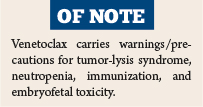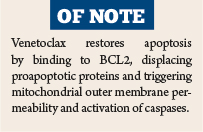In the Clinic provides overviews of novel oncology agents, addressing indications, mechanisms, administration recommendations, safety profiles, and other essential information needed for the appropriate clinical use of these drugs.
On April 11, 2016, venetoclax (Venclexta) was approved for treatment of patients with chronic lymphocytic leukemia (CLL) with 17p deletion, as detected by a U.S. Food and Drug Administration (FDA)-approved test, who have received at least one prior therapy.1,2 The accelerated approval was based on overall response rate. Continued approval may be contingent upon verification and description of clinical benefit in a confirmatory trial.
Supporting Efficacy Data
Approval was based on results of a phase II trial of the drug in 106 patients with CLL with 17p deletion, detected by an FDA-approved CLL fluorescence in situ hybridization (FISH) probe kit, who had received at least one prior therapy. Patients had a median of 2.5 prior treatments (range = 1–10). Venetoclax was given orally via a weekly ramp-up schedule starting at 20 mg and increasing to 50, 100, 200, and 400 mg once daily; patients continued to receive 400 mg once daily until disease progression or unacceptable toxicity.

The objective response rate on independent review committee assessment was 80% (95% confidence interval [CI] = 71%–87%). Complete remission was observed in 8% of patients, including 2% with complete remission with incomplete marrow recovery. Assessment of patients with complete remission or incomplete marrow recovery showed that three patients (3% of the total population) were minimal residual disease–negative in the peripheral blood and bone marrow.
Median time to first response was 0.8 months (range = 0.1–8.1 months). Median duration of response had not been reached after median follow-up of approximately 12 months, with response duration ranging from 2.9 to 19.0+ months.
How It Works
Venetoclax is a selective small-molecule inhibitor of the antiapoptotic protein BCL2. BCL2 has been found to be overexpressed in CLL cells, where it mediates tumor cell survival and has been associated with resistance to chemotherapeutics.
Venetoclax acts to restore apoptosis by binding directly to the BCL2 protein, displacing proapoptotic proteins such as BIM and triggering mitochondrial outer membrane permeability and activation of caspases. In preclinical studies, venetoclax showed cytotoxic activity in tumor cells that overexpress BCL2.
How It Is Given
Patients must be assessed for their level of risk of tumor-lysis syndrome and given prophylactic hydration and antihyperuricemics prior to the first dose of venetoclax to reduce risk of tumor-lysis syndrome. Venetoclax is given via a weekly ramp-up schedule over 5 weeks to the recommended daily dose of 400 mg; the daily doses are 20, 50, 100, and 200 mg for weeks 1, 2, 3, and 4 and 400 mg for week 5 and thereafter. The ramp-up dosing schedule is designed to gradually reduce tumor burden and decrease the risk of tumor-lysis syndrome.
Changes in blood chemistry consistent with tumor-lysis syndrome that require prompt management can occur as early as 6 to 8 hours after the first dose and at each dose increase. The risk of tumor-lysis syndrome is reduced with stratification by tumor burden, prophylaxis with hydration and antihyperuricemics, frequent blood chemistry monitoring, and correction of electrolyte abnormalities.

Detailed instructions for tumor-lysis syndrome prophylaxis and monitoring during treatment based on tumor burden determination are provided in labeling. Detailed instructions on dose modification for tumor-lysis syndrome, grade 3 or 4 nonhematologic toxicities, grade 3 or 4 neutropenia with infection or fever, and other grade 4 hematologic toxicity (apart from lymphopenia) are provided in the labeling.
Concomitant use of venetoclax with strong CYP3A inhibitors (eg, ketoconazole, conivaptan [Vaprisol], clarithromycin, indinavir [Crixivan], itraconazole, lopinavir, ritonavir, telaprevir [Incivek], posaconazole [Noxafil], voriconazole) at initiation and during ramp-up is contraindicated. For patients who have completed the ramp-up phase and are on a steady daily dose of venetoclax, the dose should be reduced by ≥ 75% when used concomitantly with strong CYP3A inhibitors. The venetoclax dose used prior to initiating the strong CYP3A inhibitor can be resumed 2 to 3 days after discontinuation of the inhibitor.
Concomitant use of moderate CYP3A inhibitors (eg, erythromycin, ciprofloxacin, diltiazem, dronedarone [Multaq], fluconazole, verapamil) or P-glycoprotein inhibitors (eg, amiodarone, azithromycin, captopril, carvedilol, cyclosporine, felodipine, quercetin, quinidine, ranolazine, ticagrelor [Brilinta]) should be avoided. If a moderate CYP3A inhibitor or a P-glycoprotein inhibitor must be used, the venetoclax dose should be reduced by ≥ 50%. The dose used prior to initiating the moderate CYP3A inhibitor or P-glycoprotein inhibitor can be resumed 2 to 3 days after discontinuation of the inhibitor.
Safety Profile
Safety data are from 240 patients with previously treated CLL who received single-agent venetoclax at 400 mg daily. The most common adverse events of any grade were neutropenia (45%), diarrhea (35%), nausea (33%), anemia (29%), upper respiratory tract infection (22%), thrombocytopenia (22%), and fatigue (21%).
The most common grade 3 or 4 adverse events were neutropenia (41%), anemia (18%), thrombocytopenia (15%), febrile neutropenia (5%), and pneumonia (5%). Serious adverse events occurred in 44% of patients, with the most common (≥ 2%) being pneumonia, febrile neutropenia, pyrexia, autoimmune hemolytic anemia, anemia, and tumor-lysis syndrome.
In an assessment of 66 patients starting at a daily dose of 20 mg and increasing over 5 weeks to a daily dose of 400 mg, the rate of tumor-lysis syndrome was 6% with no clinical events. All events were laboratory tumor-lysis syndrome and occurred in patients who had a lymph node(s) ≥ 5 cm or absolute lymphocyte count ≥ 25 × 109/L.
Venetoclax for CLL
- Venetoclax (Venclexta) was approved for treatment of patients with chronic lymphocytic leukemia with 17p deletion (as detected by an FDA-approved test) who have received at least one prior therapy.
- Venetoclax is given via a weekly ramp-up schedule over 5 weeks to the recommended daily dose of 400 mg, but patients must first be assessed for the risk level and given prophylactic hydration and antihyperuricemics to reduce the risk of tumor-lysis syndrome.
Venetoclax carries warnings/precautions for tumor-lysis syndrome, neutropenia, immunization, and embryofetal toxicity. Tumor-lysis syndrome should be anticipated. Patients with higher-risk features for tumor-lysis syndrome may require hospitalization for intravenous hydration, electrolyte monitoring, and aggressive correction of electrolyte abnormalities. Blood chemistry and blood counts should be routinely monitored. No live attenuated vaccines should be given prior to, during, or after venetoclax treatment.
Concomitant use of venetoclax with strong CYP3A inhibitors at initiation and during dose ramp-up is contraindicated. ■
References
1. U.S. Food and Drug Administration: Venetoclax (Venclexta) tablets. Available at www.fda.gov/Drugs/InformationOnDrugs/ApprovedDrugs/ucm495351.htm. Accessed May 9, 2016.
2. Venclexta (venetoclax) tablets prescribing information, AbbVie, Inc, and Genentech USA, Inc, April 2016. Available at www.accessdata.fda.gov/drugsatfda_docs/label/2016/208573s000lbl.pdf. Accessed May 9, 2016.

